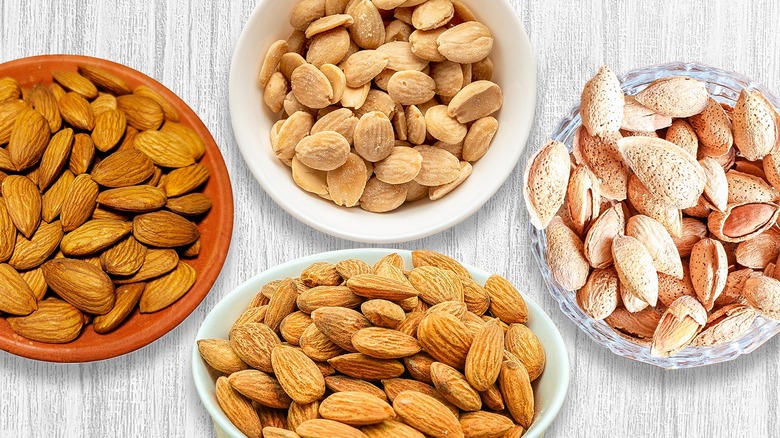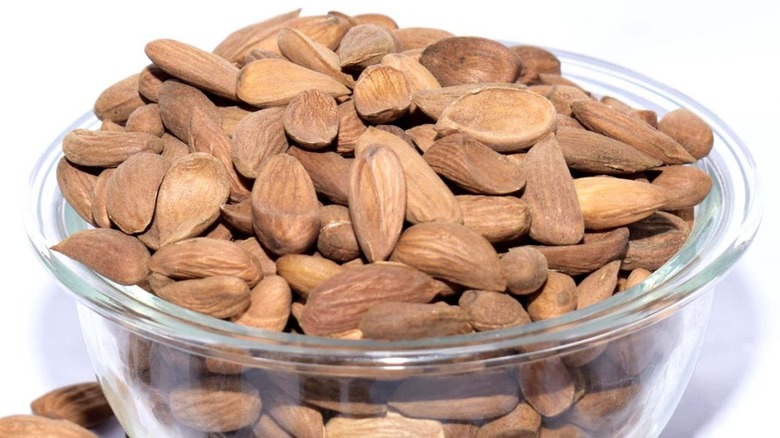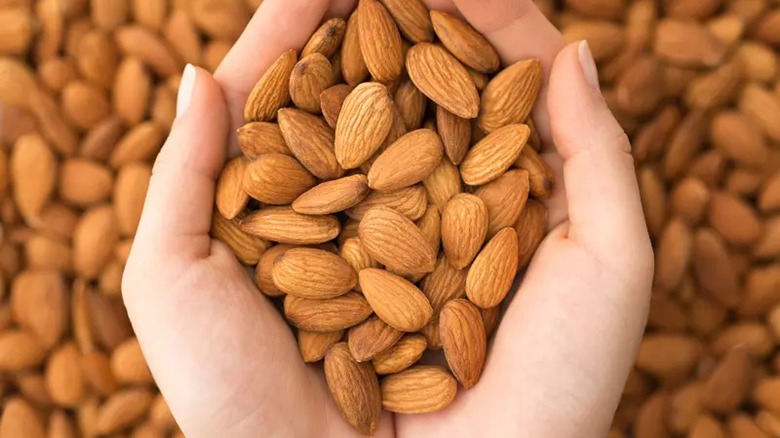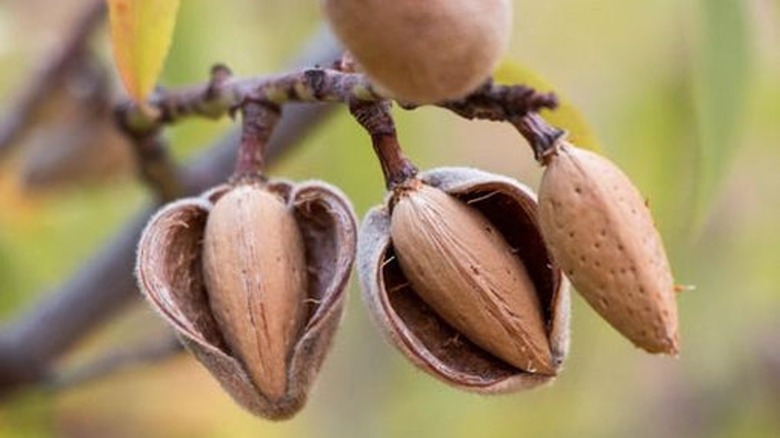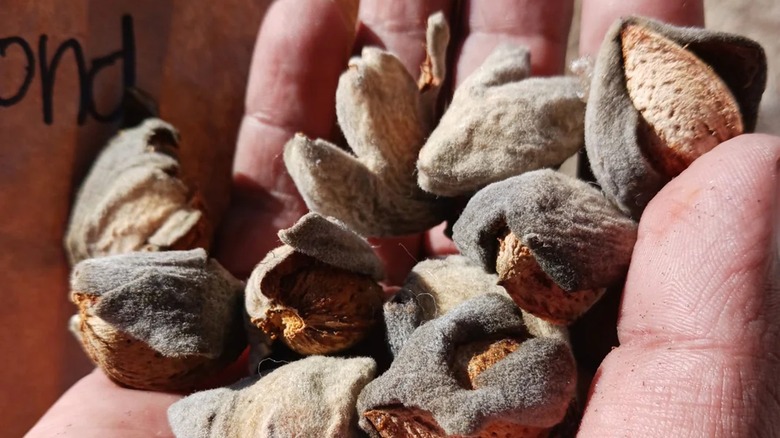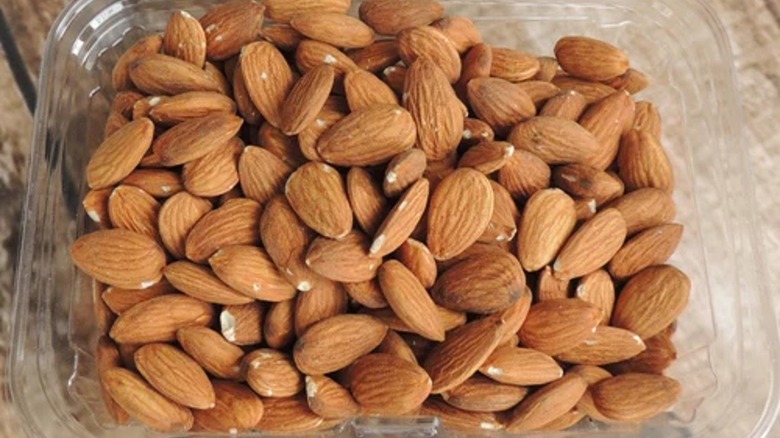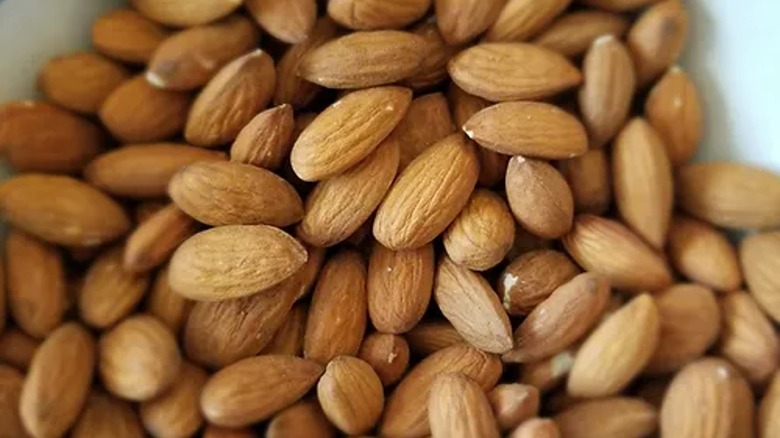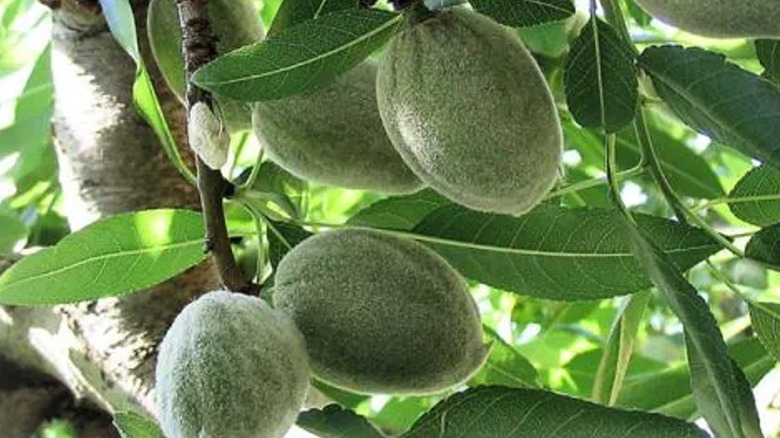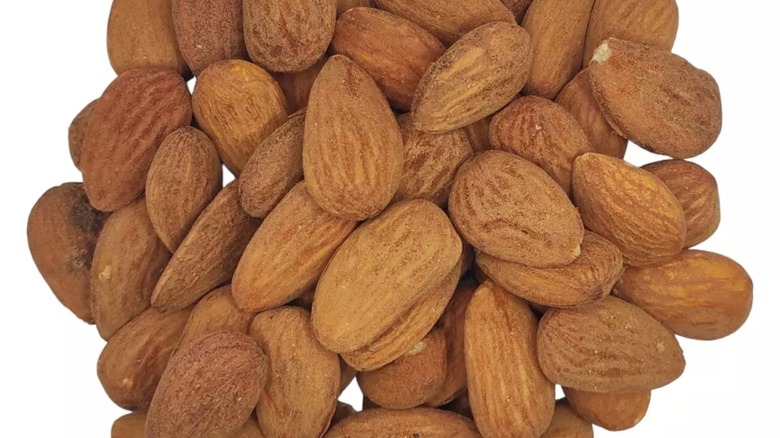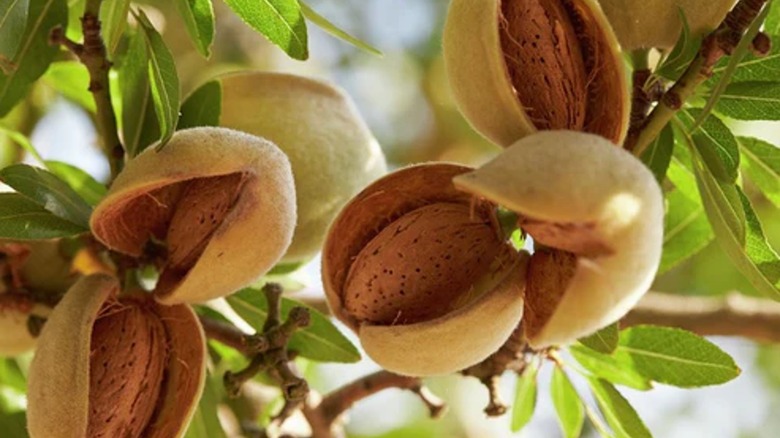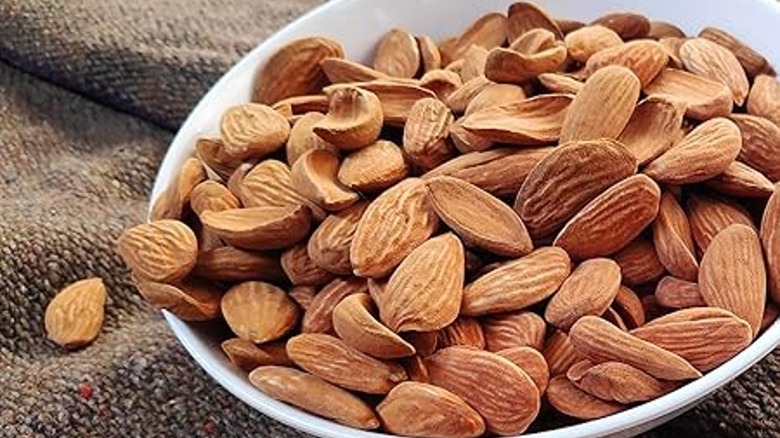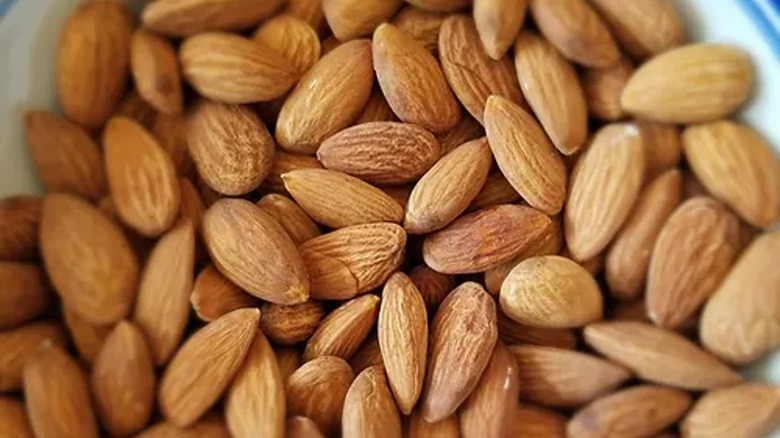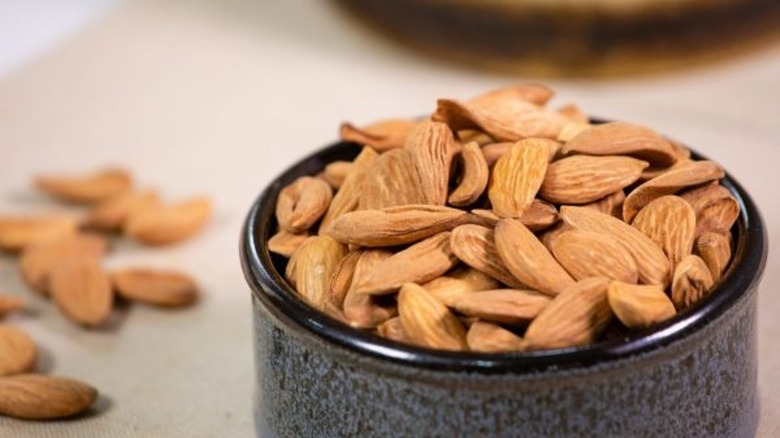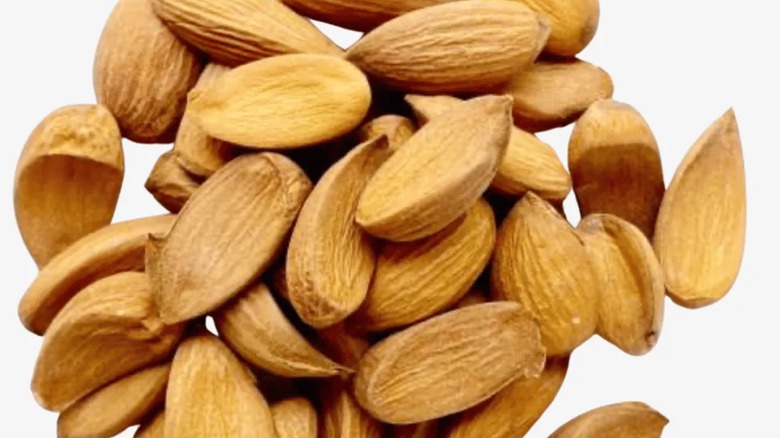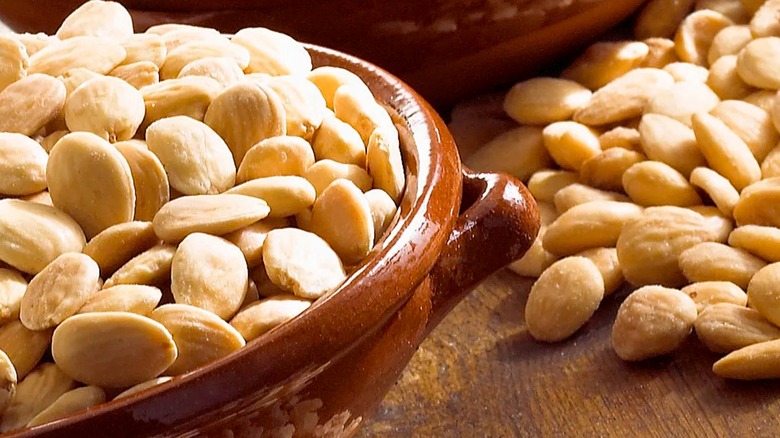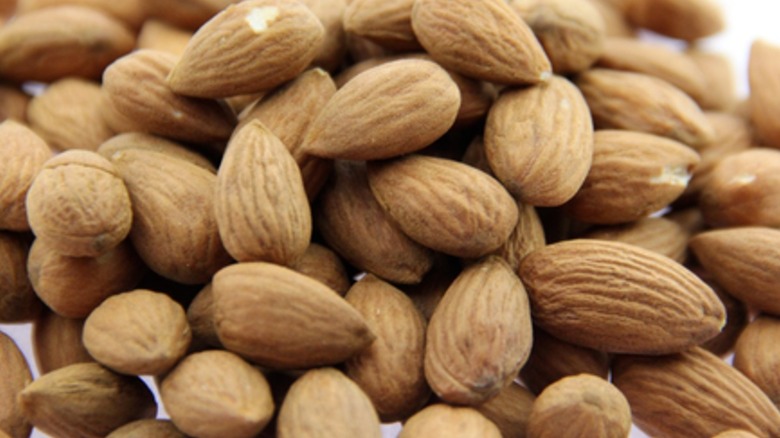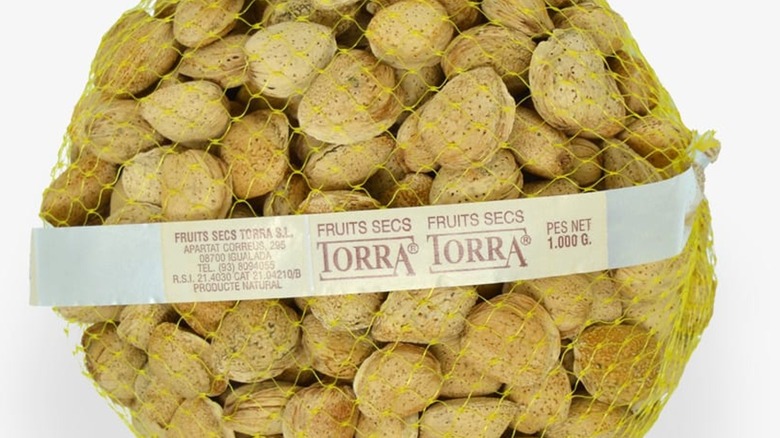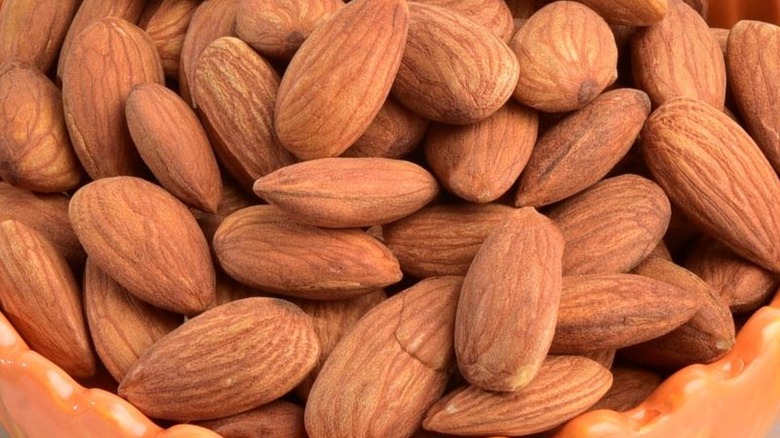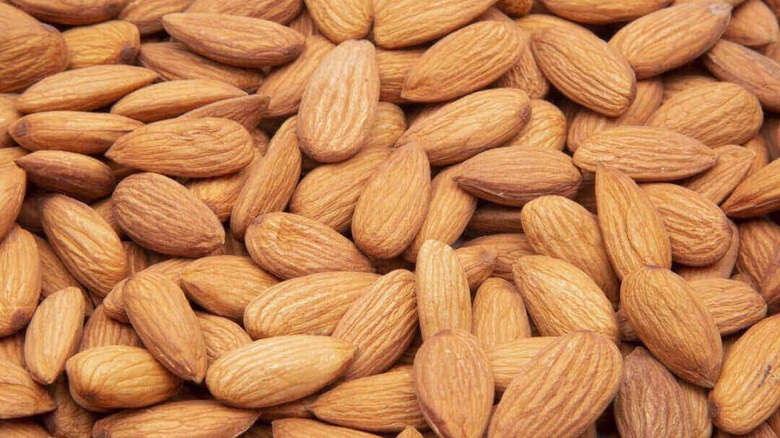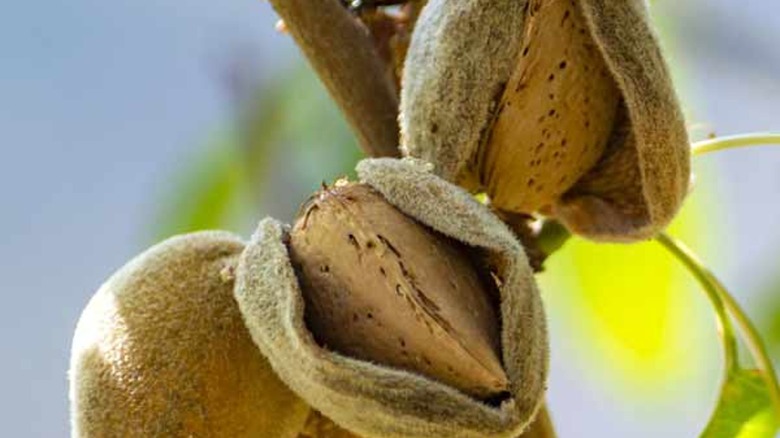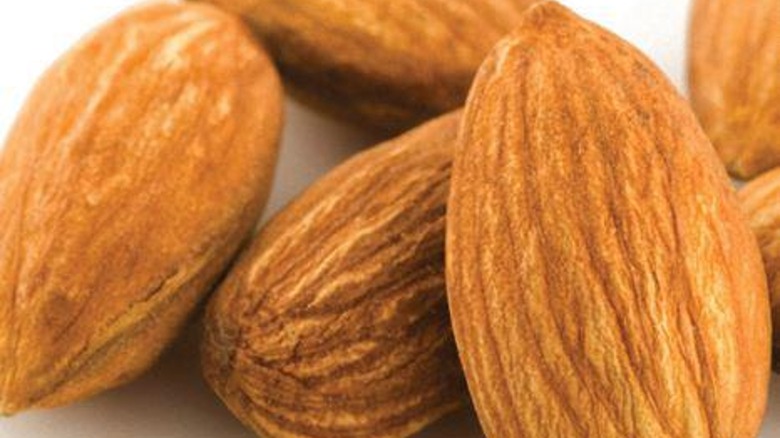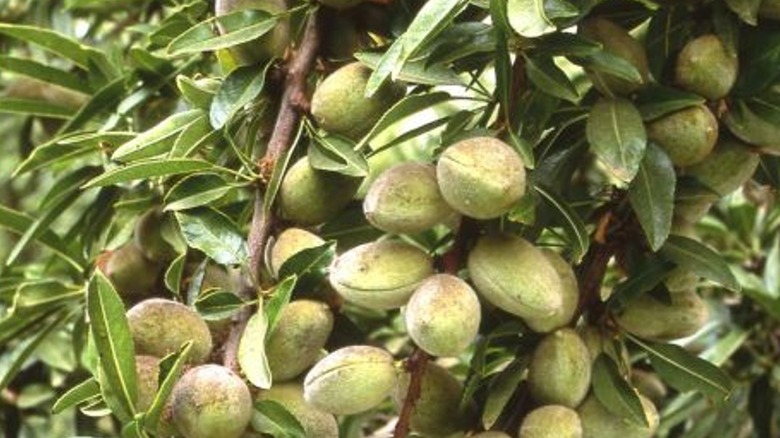23 Types Of Almonds, Explained
We may receive a commission on purchases made from links.
Whenever you're sitting around munching almonds, it might have never occurred to you that more than one type exists. However, when you think about how different almond flavoring is from the flavor of many common almonds and the difference between the best and worst almonds you've ever had, you'll realize that there are different varieties. The best ones tend to provide a completely different culinary experience than you may have previously had with almonds in the past. So, keep your eyes out for the ones on our list that might catch your interest.
Our alphabetical list of almond types covers almonds from around the world, including ones from Afghanistan, California, France, Iran, India, Italy, and Spain. Some represent subtypes of broader categories. For instance, California almonds are divided further into subtypes like Carmel, Mission, and Nonpareil. Depending on their characteristics, some varieties may even fall under multiple classifications. For example, Aldrich almonds fall under the categories of both California and Carmel. There are also three types of Mamra almonds on our list.
While our list is by no means exhaustive, they represent 24 types of almonds that you're likely to encounter, even if the specific type isn't listed on the container. We think you'll be pleasantly surprised to discover the difference between many you may have only heard about in passing (and several you've never heard of).
Afghani Mamra
There are three types of Mamra almonds: Kashmiri, Irani, and Afghani. While Mamras are not quite as sweet as Californian almonds, they have a higher oil and healthy fat content, are more nutritionally dense, and boast a rich and creamy flavor. Mamras tend to be more expensive than California almonds not only because they're imported, but also because they're picked by hand instead of being machine-picked.
The Afghani Mamra badam (almond) variety originated in cool and rocky areas of Afghanistan. They fall in the middle in size when compared to other Mamra almonds and are flatter, with a somewhat bitter flavor. The Afghani variety also has a distinctive crunch. They're more challenging to find than the others. As such, they tend to be more expensive.
Aldrich
Aldrich almonds come from California. Being medium-sized and long place them in the Carmel category of almonds. They're also narrow and flat, with a wrinkled surface.
While California almonds tend to be sweet, these are sweeter than most. They also have a delightful buttery flavor that veers closer to amaretto or marzipan. So, they tend to be a stand out for uses where the flavor matters, like when eating alone or baking with them. Aldrich almond trees are compact, have a high yield, and are resistant to lots of diseases, making them popular with farmers.
All-In-One
California is the origin of the All-In-One almond variety. These are medium-sized nuts with soft shells. Their flavor profile tends toward being sweet and nutty, while the texture is slightly crunchy.
The name "All-In-One" refers to its self-pollinating nature rather than how you can use the nuts. However, they're still versatile for eating alone, turning into almond butter, or in other dishes where you like to use almonds. Farmers especially like to grow them because being self-pollinating means they don't necessarily need a lot of extra pollination help from bee rentals like lots of almonds do. However, bees do still increase yield for self-pollinating almonds.
Butte Padre
Butte and Padre almonds are two separate California varieties. However, since they're often harvested and mixed together, you'll find them listed as Butte Padre. Being Mission-style varieties makes them short and plump. They're both dark, small, and wrinkled.
Buttes tend more toward plumpness, whereas Padres tend toward wideness. However, they're close enough to each other that mixing is fine. Their small size, as well as being hard and crunchy, make them ideal for adding to chocolate bars. Having an earthy and slightly bitter flavor suits chocolate well. They're also often used for making almond milk, almond flour, and almond paste.
California
According to the Almond Board of California, California provides around 80% of the world's almonds. So, you may not have realized almonds are not native to California. California almonds showed up from Europe as early as 1853 and have been cross-bred over the years to suit the climate and become the varieties we enjoy today.
While you're likely to find almonds simply labeled as "California almonds," this name describes quite a number of varieties grown in California that vary in shape and color. The major ones include Nonpareil, Monterey, Butte, Padre, Carmel, Fritz, Aldrich, Sonora, Wood Colony, and Price, some of which are subcategories unto themselves. So, it's difficult to make a blanket statement for them all. For example, most are easy to blanch, but the Mission variety has such wrinkled skin that it's difficult to remove them through the blanching process. However, the nutrient levels are all fairly similar.
Carmel
Many people count Carmel almonds among the best tasting since they're the sweetest of the California varieties. Several California almond varieties are considered to be Carmel types, including Aldrich, Carmel, Monterey, Price, Sonora, and Wood Colony almonds.
Carmels have soft shells and are medium in size. They're long, flat, narrow, and have a slight point at the end. And their surface is only slightly wrinkled. They have a fairly striking flavor. While they're nutty and have a little more sourness than most other Californian varieties, they also have the best crunch of any California variety. So, while you could eat these on their own, being sweet and tasting similar to amaretto makes them a good choice for desserts that feature almonds. However, they're also commonly used for roasting, blanching, milk, and butter as well.
Ferraduel
Ferraduels are hard-shelled nuts created in France by the French Institute for Invertebrate Enhancement. While many farmers use Ferraduel trees for cross-pollination purposes for more popular varieties, that doesn't mean that they're not in circulation as nuts.
Ferraduel trees are late bloomers, which means that harvest time for their nuts falls later in the year than for a lot of other varieties. So, they don't succumb to the negative consequences of late frosts that some other varieties might. You can count on these medium-sized nuts to be crunchy. Plus, their rich and sweet flavor makes them an excellent choice no matter how you want to use them.
Ferragnes
If you're looking for almonds from the Mediterranean area, you're likely to encounter Ferrangnes almonds. Some countries that grow them include Spain, Italy, and Greece.
They tend toward a large and long profile and grow in a thin but hard shell. Ferragneses have an intense and sweet flavor with a high fat percentage. They're considered a classic variety and are good to eat all by themselves. So, you'll often find them for sale in containers meant for snacking purposes.
Fritz
Fritz almonds are a California Mission variety that are common in the San Joaquin Valley area. Their overall flavor profile is fairly impactful, tending toward being sweet with less bitterness than most other California varieties.
These small , dark brown nuts grow in semi-hard shells. Despite being small, they have a medium amount of plumpness. Plus, they have a fair amount of wrinkles. Fritzes are more astringent tasting with a woodier flavor than other California types. However, they still rate among the sweetest. You also have to be patient to have access to these since they're the last type of commercial almond that's ready to pick each year in California, harvested 40-60 days after Nonpareil varieties.
Gurbandi
Gurbandi almonds are another type that originates in Afghanistan, where some farmers grow them as heirloom crops. However, this variety is not in the Mamra category, even though their concave shape makes them look similar.
You might also see them referred to as Choti Giri almonds. While they're smaller than the ones from California, they have more natural fat. Although they're on the bitter side, they're mild and sweet overall. They're softer than many varieties but still have a crunch. It's common to eat these alone or sprinkled on top of foods. Plus, they make excellent butter and milk.
Independence
Independence almonds fall in both the category of California almonds and Nonpareil almonds. Thus, they're medium-sized, light-colored nuts with a soft shell that come in a flat shape and have a smooth surface. They tend to be longer than many other almonds.
Their flavor is mild and sweet. They also have a nice crunch, making them great to snack on raw or to turn into milk. Roasting is a great option for this variety, too, making them great for salads. Because the Independence variety is self-fertile and doesn't need to rely as much on pollinators like bees, many farmers planting new Nonpareil orchards are opting for the Independence variety.
Irani Mamra
A popular type from Iran is the Irani Mamra. Irani Mamras are the largest of the three Mamra varieties. They're thin-shelled, long, and have a concave shape. Like the other Mamras, they are more nutritionally rich. While they look dry on the outside and have a firm texture, they have the highest fat content of any of the Mamras. They're also sweet, rich, and nutty.
Mamras are versatile and are great used any way you like almonds, from milk to butter and for cooking. However, they tend to be expensive because they're not mass-produced.
Kashmiri Mamra
If you're looking for Mamras, the ones you're most likely to find are Kashmiri Mamra almonds from the Kashmiri area of India. In comparison to the other Mamras, Kashmiri Mamras are the smallest. While they do have a concave shape, they're rounder in shape, have a sweeter flavor, and have a softer texture than other Mamras. However, they still have plenty of crunch.
Being harvested manually instead of by machine makes them rarer than California varieties. Fans of these nuts like eating them plain or adding them to a variety of dishes.
Marcona
The reigning favorite among almonds tends to be the Marcona almond, which comes from Spain. One person who counts Marcona almonds as a favorite is Ina Garten. These almonds' claim to fame is that they're buttery and sweeter than most almonds. Plus, they're moist and soft, with a texture that will probably remind you of a macadamia nut.
Marconas are also rounder than most almonds. So, you might not recognize them as an almond at first glance. No matter whether you want to eat them as a snack or add them to other recipes, they're a real treat. Just keep in mind that European almonds aren't required to be pasteurized, which means that they may go rancid faster, especially with the nut's high moisture and oil content. So, pay attention to the best-by-date and keep them away from heat and humidity for best results.
Mission
Mission almonds are a hard-shelled California almond variety. There are several varieties in our list that fall into the Mission category, such as Butte, Padre, and Fritz. While their hard shells result in a good yield because they deter pests, the shells also make them more difficult to process.
The nut itself is also hard and can be chewier than most. While they tend to be smaller than many other types, they have a plump, round, and wide stature. Mission nuts are dark brown (sometimes nearly black) with deep wrinkles that capture seasonings well when roasting. Their flavor is slightly sweet, but the flavor doesn't have the same level of impact as a lot of other California varieties. While they're not easily blanchable because of their deep wrinkles, roasting them in their skin can help bring out their rich flavor.
Mollar
Another popular variety from Spain is the Mollar almond. Mollars are usually sold as they are, in their easy-to-crack soft shell. However, you'll probably still need a nutcracker to get them open since the shell isn't peanut-shell soft.
When shelled, this variety is round and has a pointed end. These plump almonds are especially nutty in flavor and sweet. So, they're popular to eat raw, turn into milk, or use to make delightful marzipan or other treats. They're also great roasted in the shell. There are several types of Mollar almonds that grow in Spain. The Mollar Tarragona is the one you're most likely to hear about, but there are other types, like the Mollar Cascara as well.
Monterey
When compared to other California varieties, Montereys are slighter, with a long and narrow profile. They also tend to be flatter.
They're hard-shelled and require a lot of force to grind. Their fairly sweet flavor and meaty texture make them good for snacking. They are easy to blanch, making them good for milk, candy, and for baking, too. If you're looking for Nonpareils and can't find them, Montereys make a good substitute.
Ne Plus Ultra
Ne Plus Ultra are one of the oldest varieties of California almonds, created when almond farmers were still in the infancy stages of cross-breeding different ones to match the California climate in the early 1900s. They have a paper-like soft shell.
Like many California almonds, they have a sweet flavor profile. While Ne Plus Ultra trees won't pollinate every almond tree (such as Price), farmers like to plant them alongside Nonpareils and many of the other types because they do an exceptional pollination job with those.
Nonpareil
Nonpareil almonds originated in 1879 and are the most widely grown almonds in California. Many almond lovers prefer Nonpareils to other varieties, especially when enjoying them on their own for snacks. The love for this subcategory of California almonds comes from them being sweeter than many others, with less bitterness and a great crunch. They also have a woody and meaty flavor profile. Plus, their thin shells make them easy to open.
Nonpareils taste a lot more like what we consider to be almond flavor than many of the other varieties sold for snacking. As far as looks go for comparison to others, they're medium-sized, soft-shelled nuts with a surface that is flat and smooth. They've become popular enough that farmers have imported them to grow in countries like Spain and Australia.
Sonora
Not only are Sonora almonds a California type, but they're also considered to be Nonpareils. They're a dark brown soft-shelled variety that runs small in size. The nuts are both short and narrow. Plus, the surface has a good amount of wrinkles.
Despite being a California almond, they're also grown in places like Mexico and Australia. They have a mild flavor that is both sweet and buttery. Like Nonpareils, the flavor has a woodiness to it. Being an alternate-bearing tree, farmers get fewer nuts every other year, which is probably why they aren't as popular as they could be.
Texas Mission
Texas Mission almonds exist throughout the Southwest and may have been introduced to the area by Spanish missionaries in the 1900s. Not only will you find them in Texas but also along the Colorado River, the Rio Grande Plains, and south into Mexico.
There are rumors that California Mission almonds may have come from Texas Mission trees rather than the other way around. Texas Missions are a hard-shelled variety with small, velvety, and plump nuts. The flavor of Texas Mission nuts is a sweet one.
Tuono
Italy is the home of Tuono almonds, where they mainly grow in Sicily. If you're used to sweet almonds, you may be surprised to find that these tend to have more of a bitter flavor.
In Italy, they often get made into desserts like amaretti cookies and biscotti or ground up to become an ingredient in pesto. Despite having less oil than some other varieties, they still sometimes get turned into oil. Plus, they're good for a variety of cooking and baking applications.
Wood Colony
One Carmel type of California almond that you may encounter is Wood Colony, named after an area in the San Joaquin Valley full of almond and walnut orchards. David E. Blickenstaff discovered this variety in his Modesto, California almond orchard, and it was patented in 1985.
Their medium-sized nuts come in a semi-soft shell. The nut itself is long, narrow, and flat with somewhat wrinkled skin. Like other Carmel-type nuts, these are sweet. Their size makes them especially good to use for almond slivers and for roasting.
